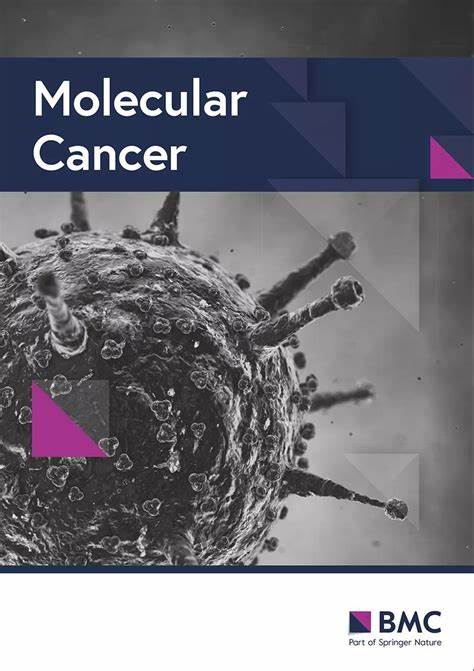Harnessing ovarian cancer ascites for translational science: models, biomarkers, and therapeutics
IF 33.9
1区 医学
Q1 BIOCHEMISTRY & MOLECULAR BIOLOGY
引用次数: 0
Abstract
Ovarian cancer is one of the most lethal gynecological malignancies and is often associated with fluid build-up in the peritoneal cavity, known as ascites. Nearly one-third of patients with ovarian cancer present with ascites at the time of initial diagnosis, and more frequently with recurrent ovarian cancer. Ascites is a uniquely valuable tool for research, as it is representative of both the tumor and its microenvironment. Ascites is composed of cells (single cells and multicellular aggregates) and acellular components that contribute to the development of peritoneal metastasis and chemoresistance. Ascites is an underutilized resource that provides an opportunity to improve our understanding of ovarian cancer biology, identify novel drug targets, assess drug responses, and identify diagnostic and/or prognostic biomarkers. This review summarizes the current understanding of ovarian cancer ascites with a focus on, (1) etiology, (2) cytopathological and molecular characterization, (3) the role its cellular and acellular components play in shaping the tumor microenvironment, and (4) its application in translational research for drug development (organoids and patient-derived ascites xenografts) and biomarker discovery. Lastly, options for the treatment of malignant ascites, along with future opportunities to use ascites as a translational research tool to improve our understanding of ovarian cancer biology and to develop new therapeutic strategies, are discussed.利用卵巢癌腹水的转化科学:模型,生物标志物和治疗方法
卵巢癌是最致命的妇科恶性肿瘤之一,通常与腹腔积液有关,称为腹水。近三分之一的卵巢癌患者在最初诊断时存在腹水,更常见的是复发性卵巢癌。腹水是一种独特的有价值的研究工具,因为它代表了肿瘤及其微环境。腹水由细胞(单细胞和多细胞聚集体)和非细胞成分组成,它们有助于腹膜转移和化疗耐药的发展。腹水是一种未被充分利用的资源,它提供了一个机会来提高我们对卵巢癌生物学的理解,确定新的药物靶点,评估药物反应,并确定诊断和/或预后生物标志物。本文综述了目前对卵巢癌腹水的认识,重点包括:(1)病因学,(2)细胞病理学和分子特征,(3)其细胞和非细胞成分在形成肿瘤微环境中的作用,以及(4)其在药物开发(类器官和患者来源的腹水异种移植)和生物标志物发现的转化研究中的应用。最后,讨论了恶性腹水的治疗方案,以及未来利用腹水作为转化研究工具以提高我们对卵巢癌生物学的理解和开发新的治疗策略的机会。
本文章由计算机程序翻译,如有差异,请以英文原文为准。
求助全文
约1分钟内获得全文
求助全文
来源期刊

Molecular Cancer
医学-生化与分子生物学
CiteScore
54.90
自引率
2.70%
发文量
224
审稿时长
2 months
期刊介绍:
Molecular Cancer is a platform that encourages the exchange of ideas and discoveries in the field of cancer research, particularly focusing on the molecular aspects. Our goal is to facilitate discussions and provide insights into various areas of cancer and related biomedical science. We welcome articles from basic, translational, and clinical research that contribute to the advancement of understanding, prevention, diagnosis, and treatment of cancer.
The scope of topics covered in Molecular Cancer is diverse and inclusive. These include, but are not limited to, cell and tumor biology, angiogenesis, utilizing animal models, understanding metastasis, exploring cancer antigens and the immune response, investigating cellular signaling and molecular biology, examining epidemiology, genetic and molecular profiling of cancer, identifying molecular targets, studying cancer stem cells, exploring DNA damage and repair mechanisms, analyzing cell cycle regulation, investigating apoptosis, exploring molecular virology, and evaluating vaccine and antibody-based cancer therapies.
Molecular Cancer serves as an important platform for sharing exciting discoveries in cancer-related research. It offers an unparalleled opportunity to communicate information to both specialists and the general public. The online presence of Molecular Cancer enables immediate publication of accepted articles and facilitates the presentation of large datasets and supplementary information. This ensures that new research is efficiently and rapidly disseminated to the scientific community.
 求助内容:
求助内容: 应助结果提醒方式:
应助结果提醒方式:


